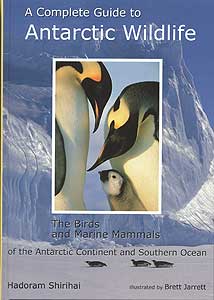
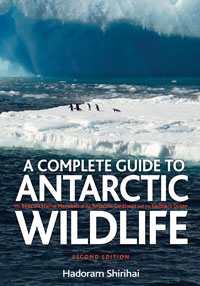
A Complete Guide to Antarctic Wildlife

The birds and marine mammals of the Antarctic Continent and Southern Ocean
Hadoram Shirihai, Brett Jarrett
About the first edition (upper picture)
- Alula Press Oy Finland, 2002 ISBN 951.98947.0.5
- Princeton University Press, 2003. ISBN 0691114145 (New cover but content identical as Alula edition)
- Introduction to Antarctica: geology, different types of ice, climate and historical expeditions
- Faune of Antarctica and the subantarctic islands: birds (penguins, albatrosses, stormpetrels, etc.), seals and fur seals and ceteceans. Very detailed with lots of photographs and plates of animals in different looks (young-adult, male-female, colour variations). This part accounts for about half of the volume.
- Account of all (sub)antarctic islands and archipelos (which animals live there, when and how many?), including checklists.
About the second edition (lower picture)
- Princeton University Press, 2007. ISBN: 9780713664065
Should you buy the second edition (544 pages, 900 photographs, 35 plates) if you already own the first edition? Well, it depends. No: the book is still the same, more or less. The text has been revised, but has not changed (updated) dramatically. Yes: for you will find many more photographs and improved plates, mainly of albatrosses and storm petrels, that will help to improve their determination. Shirihai has delivered an incredible job when one realizes how difficult it is to photograph animals at sea. For this edition Shirihai has managed to photograph even the fast-flying diving petrels. No pictures were included in the first edition, yet in the second he managed to include multiple pictures of all three species! Because of all these new photographs the book has grown 40 pages thicker. The author's sales revenus are donated to BirdLife's Save The Albatross campaign, a very nice gesture indeed!
For me, this second print remains both my all-time guide and reference book about Antarctic wildlife. I have compared the first and second print to spot what has changed. The structure of the second edition remained the same but has been improved in other points:
- 300 new photographs. A small number of photographs has been deleted.
- Improved layout: the text and tables are easier to read.
- Three plates are completely new (2 for great albatrosses, 1 for prions).
- The plates for whales and dolphins and other sea mammals have been completely revised.
- The inner cover has been used for the 'Bird and Marine Mammal Topography' and for maps
- Clearer table of contents and condensed index of key words
- The new plates, drawn by John Cox, are a real treat for the eye. All birds are grouped together. The birds (great albatrosses and prions) are depicted in flight (both from above and underneath) and sitting on the water. John Cox previously illustrated Michael Brooke's 'Albatrosses and Petrels across the World' (see further down this page).
- Some plates of whales and dolphins have been revised too. For this second edition the drawings have been used from Shirihai's other guide 'Whales, Dolphins and Seals' (2006).
- Improved reproduction of the photographs (e.g. the photographs on page 28-29 and 484 are much better than the ones on in the first Princeton edition on pages 38-39 and 436).
- bird species, most of all: albatrosses (beautiful pictures of Amsterdam albatross for example), penguins, blue petrel and prions, stormpetrels and diving stormpetrels, shags, great skuas, gulls and terns, and buntings of the Tristan archipelo.
- dolphins, especially Killer Whales. But also beaked whales and porpoises, sea mammals that are hard to spot let alone to photographs at sea. Again, some photographs were published earlier in Shirihai's guide 'Whales, Dolphins and Seals' (2006). But new photographs of common species like the Humpback Whale have also been included.
- Seals, fur seals and sea lions.
- A few series of photographs have been included, similar-looking species shown from the same angle. This should make comparisons (and identification) easier. As an example I'd like to mention the four photographs of crested penguins from New Zealand, all floating on the water.
Two points of criticism are the bad print (too small) of the food chain (page 20) - the one in the first edition was better. The photograph on page 104 still contains ugly dust particles from the camera's chip - they should have been edited to remove them. But it must be clear from this comparison that Shirihai has succeeded to improve his book, but not to change it!
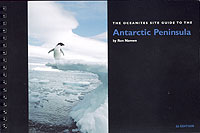
The Oceanites Site Guide To The Antarctic Peninsula

Ron Naveen
Oceanites Inc., USA 2005. ISBN 978-0-9661011-0-2
A5-sized handbook which covers in 130 pages the landing site on the Antarctic Peninsula. Maps and text explain for each of these spots which species of plants and animals live there, and how negative impact of vistors (tourists and researchers) can be limited as much as possible. Indispensable for Antarctic nature guides, and fortunately reprinted - so available again.
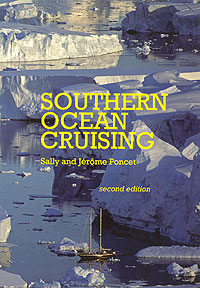
Southern Ocean Cruising
Sally & Jérôme Poncet
2nd edition. Revised and updated by Sally Poncet, Colin Harris and Susie Grant. (First published in 1991)
Environmental Research & Assessment Ltd., 2007. ISBN 978-0-9552205-1-7
This is a very compact (A5, 160 pages) guide which describes populair landing sites for yachts and cruise ships to Antarctica and all sub-Antarctic islands. The approach is similar to the Oceanites Guide (see above) but it covers more sites. It lists do's and dont's for each site and includes a map. A must for Antarctic guides and small boat owners who visit the region, in order to keep human influence and distubance to a minimum.
See also the publisher's website.
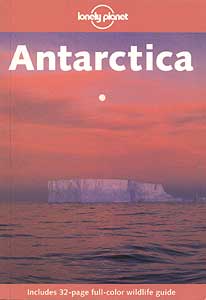
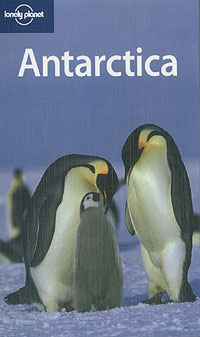
Antarctica (Lonely Planet)

Jeff Rubin
Publisher: Lonely Planet
- 2nd edition: September 2000 ISBN 0864427727
- 3rd edition: 2005, 1-74059-094-5
Practical paperback (376 pages), which deals with many aspects of Antarctica in a compact manner. Contains many maps and overviews, also for cities from which expeditions leave. The colour insert on the animal life on Antarctica is small.
About the 3rd edition
The third edition has become slightly thinner, 328 pages. The full-color wildlife guide from the previous version is gone now, but it's better to take a real wildlife book with you anyway. Clear layout and the inevitable Emperor penguin on the cover!
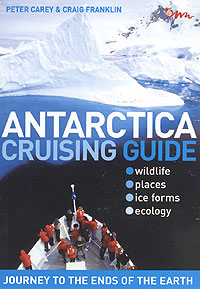
Antarctica Cruising Guide

Peter Carey & Craig Franklin
Publisher: Awa Press, New Zealand. 1st print 1996, ISBN 978-0-9582629-4-1.
A pocket guide that is lavisly illustrated with an attractive layout. If the 'Oceanites Site Guide' (above) is the guide for nature guides and expedition leaders, this booklet is an introduction for the visitor looking for general and short descriptions of the most known landing sites on the Antarctic peninsula, or about wildlife (but only the most common species), ice and ecology.
Do not expect in-depth background information, and there is also no information on historical expeditions. There are good chapters though on the threats to Antarctica. There are a couple of errors which should have been avoided; the albatross on top of page 118 is not a Black-browed Albatross, but a Campbell Albatros (with its yellow eye). Overall, the content does not add a lot to the Lonely Planet or Oceanites Guide. 233 pages.
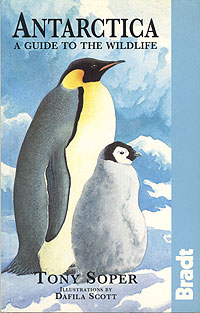
Antarctica - A Guide To The Wildlife

Tony Soper
Publisher: Bradt Publications, UK. 1st print 1994. 2nd, revised edition 1996, ISBN 1-898323-47-X. Illustrations by Dafila Scott.
Practical guidebook (just 144 pages) which covers all wildlife (birds, seals, whales, dolphins) by providing a short description, illustration (no photographs) and a small distribution map. Also with an introduction on the continent, a page on common fish species (nice!) and a practical checklist with translations in English, French, German, Spanish on the flipside inside of the cover. Concise but fairly complete.
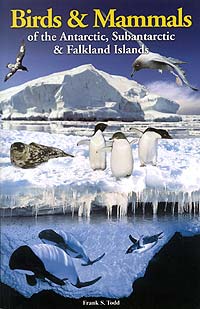
Birds & Mammals of the Antarctic, Subantarctic & Falkland Islands

Frank S. Todd
Publisher: Longitude Books, 2004. ISBN 0.934797.22.6
Paperback photo guide (138 pages) to all the animals on Antarctica and the Subantarctic islands. Even though may subspecies are mentioned, the descriptions are limited to a few key phrases. Handy in international company are the lists in the back with German, French and Spanish names.
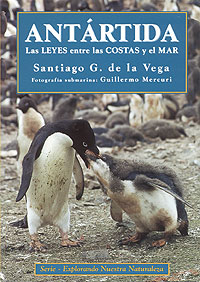
Antártida - Lay LEYES entre las COSTAS y el MAR

Santiago G de la Vega
Publisher: Contacto Silvestre, Argentina. 1st print 2000, ISBN 987-97402-4-6. Series 'Explorando Nuestra Naturaleza'
This is a thin (129 pages) soft-cover publication in Spanish language, and therefore only of interest if you speak the language. Nonetheless it is an interesting little book because it covers a relatively good portion of content to the base of all life on Antarctica: the algea, the plankton, copepods, but also the fishes and other life below the water surface - elements that are hardly covered in other guides. It is a pity that it includes a couple of commercial advertisements too. For sale in Ushuaia, Argentina (Museo Territorial, Maipu street).
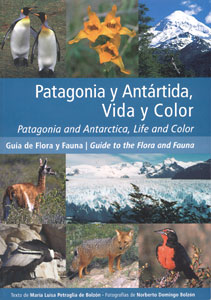
Patagonia y Antártida, Vida y Color (Patagonia and Antarctica, Life and Color)

María Luisa Petraglia de Bolzón, Norberto Domingo Bolzón
Publisher: María Luisa Petraglia de Bolzón, 2005. ISBN 987-43-9902-3
Paperback, 153 pages.
Practical and small guide, crammed with information (in English and Argentinian-Spanish) on flore and faune. Although the guide does cover Antarctica, its main interest is its coverage of Patagonia. Many species of plant and animal are covered (including the Latin/scientific names) and include a small picture. There's no space for identification characteristics and other explanations, but different biotopes are covered through general introductions. The small size of this guide limits its content, but makes it at the same time a very easy one to carry with you on a hike. For sale at bookshops in Ushuaia (Argentina).
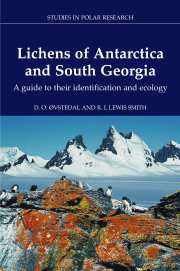
Lichens of Antarctica and South Georgia - A Guide to their Identification and Ecology
D. O. Øvstedal, R. I. Lewis Smith
Publisher: Cambridge University Press, 2006. ISBN 0.521.66241.9 (hardback). Also available as softcover.
Hardback, 424 pages
Lichens are fascinating organisms that are well adapted to cold regions. This very specialized guide will be too detailed for most visitors to (sub)antarctic islands. However, this may be the only guide on this topic for this region. The general introduction is followed by photographs and text that help to identify the 427 taxa descibed in this book (41 remain unidentified).
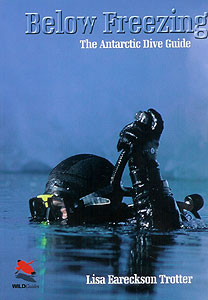
Below Freezing - The Antarctic Diving Guide

Lisa Eareckson Trotter
Publisher: WILDGuides, 2006. ISBN 1-903657-10-5
Paperback, 117 pages.
Thin and practical guide, aimed at people wishing to dive in Antarctica waters and those of South Georgia, or at those who are interested in life under water (it has good photographs/video stills). The first section covers the history of diving on Antarctica, safety and health information, provides tips about diving and photo gear. Starting on page 45, twenty five diving sites are described, on the Antarctic peninsula (19) and South Georgia (6). Each description points out the dangers and what one can expect to see on which depth. Diving in this part of the world is not without real danger, something supported by the fact that the book is dedicated to a friend-diver who has died whilst diving, and by the four pages that describe the case of the BAS researcher who did not survive the attack of a Leopard Seal. Contains glossary and literature overview. For sale in bookshops in Ushuaia.